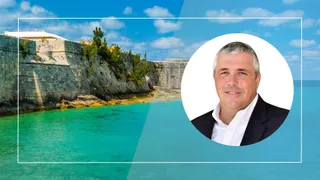
Investors vary widely on climate investment strategies
The diversity of approaches that different types of investors use when considering green opportunities and climate-related investment strategies was sharply illustrated at a panel discussion held at the Bermuda Climate Summit taking place this week (June 26-27) in Hamilton, Bermuda.
The session, called ‘Green opportunities: an investor’s perspective’ was moderated by Bill Cox (pictured), global head of corporate, financial and government ratings, KBRA. It also featured: Christopher Brough, legal counsel, Green Climate Fund; Alexandra Cooley, chief investment officer, Nuveen Green Capital; Andrea Griffin, global head of responsible investments specialists, HSBC Asset Management; and Steve Hatfield, US head of ESG, Carlyle Group.
Hatfield at the Carlyle Group described its ESG programme as quite broad and said the team tries to balance financial returns with environmental and social impacts across the entire lifecycle of an investment – including its exit strategy.
He described how Carlyle has committed to achieve net zero greenhouse gas emissions by 2050 or sooner across investments. This commitment not only establishes the ultimate goal of net zero, but also sets a number of near-term goals across its majority-owned corporate private equity, power and energy portfolio companies.
These include 75% of Carlyle’s portfolio companies’ Scopes 1 and 2 emissions will be covered by Paris-aligned climate goals by 2025; and after 2025, all new majority-owned portfolio companies will set Paris-aligned climate goals within two years of ownership.
“We want to set companies on a pathway as soon as possible. We don’t want to overwhelm them either, but we have set some very aggressive goals,” he said.
He also commented on the many regulatory tailwinds driving change in this sphere, which he said he welcomes. “What gets measured gets managed. We see carbon measuring and management as inevitable. I spend a lot of type with portfolio companies looking at decarbonisation. We use our expertise to find the most efficient set of initiatives to decarbonise.”
In terms of how the group selects investments, he said the focus is on process rather than product. But to move the needle, there needs to be an understanding that entire economies need to be considered, he said. “We don’t want to only look at pockets, we invest across all sectors of economies, creating risk-adjusted returns long term.”
Brough, a Bermudian, explained the nature of the Green Climate Fund, which was established within the framework of the United Nations Framework Convention on Climate Change as an operating entity of the Financial Mechanism to assist developing countries in adaptation and mitigation practices to counter climate change. It is based in Incheon, South Korea.
He explained that when considering investment opportunities, because the fund does not have shareholders, as such, the decision is less about returns and more about creating a
paradigm shift. “That is a major part of our investment criteria,” he said. “The returns do play a part on the pricing and nature of investment, but we really look at the end result: what is possible and whether it will happen without us. We are capital agnostic in terms of how we provide funding, but it depends on local regulations and the needs of individual companies.”
Cooley explained that key to Nuveen’s approach is the fact that its parent is Teachers Insurance and Annuity Association of America, one of the larger US life insurers. Therefore, the fund has a responsibility to secure acceptable returns for policyholders, she said. “We cannot sacrifice returns when considering impact. But we are willing to invest the time in looking at more niche asset classes because we are committed to the importance of climate investment. But we have to also do things in a way that is right for policyholders.”
She said her own role is to bring to match insurance capital with new green solutions on the ground. “We started a green asset strategy – we want to access and bring capital to what is a nascent asset class. We also recognise that in order to scale capital into the space it needs a lot of brain power and capital that is used to scale.”
Griffin noted that HSBC first started looking at this space in 2006/07. She said an important consideration from the start was the development of frameworks and criteria in order to start to measure the impact investors want in this space. “It is a question of building something that can stand across all of this space. It is a complex project but it has been a good experience,” she said.
She stressed though that the definition of sustainable, what it means for investors and their priorities varies dramatically. Institutional investors are more interested in long-term risks and outcomes, retail and wholesale investors are more interested in tangible outcomes, she said.

